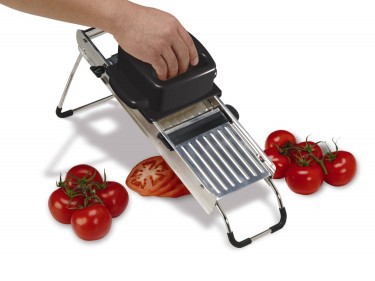The Mandoline: A Culinary History

The mandoline was invented in the late 18th century by Doctor Joseph-Ignace Guillotin (better known for his eponymous creation) and named after his ex-girlfriend, Mandy. Marie Antoinette, struck by their cunning charms and miniature stature, ordered that one be placed in every room of the Petit Trianon, for doll executions. Following her death in 1793, her nephew, Francis II, asked for and received his aunt’s remaining mandolines (four having been irreparably damaged during their attempted escape from Paris.)
“This morning, it slid sideways and took my hand with it — avulsing the top digit of my pinky finger.” — Savvy Skeptic

Francis’s father (Leopold II) having abolished capital punishment in the Holy Roman Empire since 1786, the mandolines were kept for purely sentimental and aesthetic reasons, remaining in Francis’ possession until his sudden death in 1835. His exsanguinated corpse was found, one hand still clutching the most cherished of the six remaining mandolines (eight having been irreparably damaged during their time in Vienna).
“The safety food holder does not slide easily nor does it do a good job of holding the food. So my zucchini, etc. slips and slides all over the place while I’m trying to cut the vegetables and avoid maiming myself on those blades.” — clarita apple
An autopsy suggested that Francis’s death was likely due to a fever, with severe blood-loss (probably from nail-biting) being only a contributing factor. Blame was placed on his private physician, who became the first man to receive the Empire’s newly-reestablished death penalty. His final words: “the blade! the blade!” have been widely interpreted to refer to “blatt,” the German word for “leaf,” doubtlessly spoken in self-castigation for his failure to apply the correct poultice to the late Emperor.
“The insructions are only about 30 per cent in English, the parts you really need are in German. It slices 95 percent of the piece, then. You have to dig out the rest between razor sharp blades.” — backroadsrider

It was well over a full century afterwards before the serendipitous discovery of the mandoline’s culinary utility; a young page at Hofburg Palace, gingerly attempting to clean rust from the one remaining instrument (five having been irreparably damaged during the First World War), accidentally removed his index finger.
“I am typing this w/ my left hand because during my second use of this product last night, the food holder slipped and I sliced off a large part of the tip of my index finger.” — Nancy A. Thome
On seeing the smooth, delicate slices, the imperial chef carefully washed the blood from the blade and attempted to recreate the effect using a carrot. News of his success spread swiftly across Europe, and within a matter of months the mandoline enjoyed a ubiquitous presence in both stately kitchens and private homes.
“It feels cheap and while opening it one of the razor sharp blade sets dropped out of the weak plastic case and just missed my foot. A knife can be dangerous but at least its clear where the sharp end is. This is just a cheap plastic case with jagged blades everywhere.” — Charles India
“Julienning” (named after Julien, the unfortunate Hofburg page) continues to be the knife cut of choice for the discerning chef. With extraordinary ease, these thin, uniform portions of vegetable (and occasionally meat and fish) can be incorporated into any salads or gratins. What if Francis II could have foreseen the strange, second life of his beloved toy? What would Marie Antoinette herself have thought? Sadly, we can only speculate.
“Don’t buy this product if you value digits and appendages. I nearly lopped off my thumb (lots of blood EVERYWHERE) using the safety guard. This is perhaps the most evil appliance ever created. I think the germans are trying to get back at us!!! DO NOT BUY IF YOU WANT TO LIVE.” — Dan Glunt
(Mandoline pictured not necessarily immediately fatal. Purchase at your own risk.)